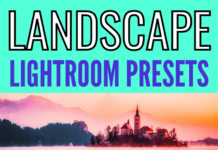If you click on the links in this post, we may earn money from the companies mentioned in this post, at no extra cost to you. You can read the full disclaimer here.
Pinterest can be a wonderful – and inexpensive – marketing tool for a small business owner or blogger. You can use the platform to drive traffic to your website or blog. (We go over how to use Pinterest for business marketing here.) If you’re working on a social media plan, you’ll definitely want to include Pinterest as part of your marketing strategy.
But how do you actually design the pins that you’ll be posting on Pinterest?
Luckily, in 2023, there are a lot of different methods for creating pins.
Whether you’re looking for very easy or more creative ways to create a pin for Pinterest, read on. We’re going to go over some of the best ways to create your own Pinterest pin.
Canva
I love using a lot of different methods to create pins. However, Canva is the one design tool I use the most.
Canva is an easy to use design tool with lots of fantastic templates. You can use it for creating social media posts as well as flyers, invitations, planners, Zoom virtual backgrounds, and much more.
But since we’re talking specifically about making pins, you can choose from over 11,000 pin templates and then edit it to change the words and/or photos. And if that number sounds overwhelming, don’t worry. You can sort by different filters like theme, subject, topic, etc.
And if you’d like access to even more Canva templates, that’s possible, too. There are lots of Pinterest templates available for purchase on Etsy.
You can use Canva for free, but I recommend getting Canva Pro (for one person) or Canva for Teams (if other people will be using it with you). You can pay annually or a monthly fee. And I think the paid Canva versions are well worth the cost.
With the paid versions, you’ll get access to over 100 million(!) stock photos, graphics, videos, and audio. And you’ll get to use some of Canva’s special features, like the built in social media scheduler and the Background Remover. You can find out more about why Canva Pro is worth it here.
Ready to get started with Canva? You can sign up for Canva here (the free or the paid versions).
And if you want to gain more Canva skills, check out these courses about Canva for beginners.
Stencil
Stencil is another graphic design tool I’ve used for years to create pins. It’s somewhat similar to Canva; I actually go over a comparison of Canva and Stencil here.
There’s a free version, but you only get to save 10 images a month. There are also a couple of paid options – like with Canva, you can pay annually or on a monthly basis.
I previously bought a lifetime deal for Stencil on AppSumo, so I can save an unlimited number of images a month. At the time of publication this deal is not available, but if you’re able to get it then I highly recommend taking advantage of it. And even if you can’t take advantage of the deal right now, Canva is still worth it.
PowerPoint
Did you know that you can use PowerPoint to create Pinterest pins?
I recently purchased SociGraphic Gold, a collection of social media graphics that you can customize for your own blog, brand or business. And the neat thing is that they were made with PowerPoint!
You can edit the graphics in SociGraphic Gold to use on Pinterest. (You’ll export the slide as an image so it will be in the right format – there’s a video tutorial that explains it in detail.) And you can also use PowerPoint to make your own pins “from scratch.”
Note: I’ve also used Google Slides (a similar program) to create pins. If you use Google Workspace, Google Slides is one of the included apps. You can get a promo code for a Google Workspace business plan here.
Photoshop
While I’ve used Photoshop a lot longer than other graphic design tools like Canva and Stencil, I actually find Photoshop to be more complicated and less intuitive. If you’re comfortable in Photoshop, though, it can be a powerful tool to use for pin creation. And because Photoshop is widely used, you can find a lot of Photoshop Pinterest templates for sale on Etsy.
Tailwind Create
When I first started using Tailwind, it was primarily a Pinterest scheduler. (At least, that’s how I used it!) But since then, it’s added a number of other features, including an AI Ghostwriter. But when it comes to pin creation, the most relevant feature is Tailwind Create.
Basically, you can input the URL of a blog post or web page, and Tailwind Create automatically generates a number of possible pins for you. You can customize it by changing the color palette or the title on the pin. And it’s not just limited to pins – you can use the tool to create other social media graphics as well. I talk about it in more detail in this Tailwind Create review.
You can sign up for Tailwind here – a free account will let you create 20 social media posts (including pins) a month. And there are paid options that let you create more, even up to an unlimited amount a month.
Conclusion
As you can see, there are a lot of different ways you can create a pin for sharing on Pinterest. And some of these design tools have free options, so you can try multiple programs and see which one works best for you.
If you’ve never made a pin before, I recommend starting with Canva. But if you’re new to pin creation and feeling anxious about designing your first pin, then consider starting with Tailwind Create. Since Tailwind Create does most of the designing work for you, it’s the easiest way to start making pins.
No matter which method you choose, we hope you enjoy making Pinterest pins!






























